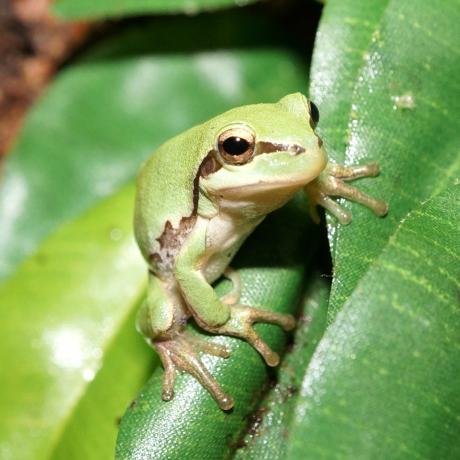

European Green Tree Frog are green in colour with a dark lateral stripe that runs from the nose down to the groin area. These are very hardy to keep in captivity requiring lower temperatures compared to other tree frog species.
| Origin | Europe |
|---|---|
| Environment | Woodland and open areas |
| Adult Size | 3-5cm |
| Suitability | Beginner |
| Lifespan | Up to 15 years |
| Food Type | Insectivores |
The European Green Tree Frog is a small to medium-sized frog reaching an adult size of 3-5cm (1.2-2 inches). The skin is smooth, green in colouration along their back, however, temperature and lighting can have an effect allowing them to be yellow, brown or grey. The belly is white to yellow and a dark stripe with a white edge runs from the nose down to the hips. They have a plump appearance, golden eyes, webbed feet with well-developed adhesive disks on their fingers and toes.
As the name suggests, the European Green Tree Frog has a vast native area, they can be found pretty much throughout Europe except Southern Spain, Southern France, and Italy.
They will inhabit gardens, vineyards, orchards, parks, most places that have access to ponds, lakes, streams, reservoirs and water ditches. This is one species that can survive our climate here in the UK as long as they have cover during the winter months. At no point should these ever be released into the wild and any animals kept in a greenhouse, must be fully escaped proof.
Keep European Green Tree Frogs in an arboreal glass terrarium, a 30x30x45cm would be suitable for a couple of frogs, or provide a larger enclosure and have a larger group to view. These need to be kept cool compared to most tree frog species, the basking area shouldn’t go above 24° C (75F). This can be achieved with a ceramic reflector clamp lamp, low basking bulb connected to a dimming thermostat. For nighttime temperatures, switching the heat source off and allowing this to drop down to room temperature is generally the best way. This species will hibernate during winter so temperatures can drop down to 5-10C (40-50F). We provide all our amphibians UVB as most will require ‘zone 1’ on the Ferguson index scale, the small amount of heat produced by the product will also benefit this species.
Use a tropical mix designed for forest species which includes soil, forest bark and moss, this mixture will help keep humidity levels a little higher too. Provide plenty of coverage in the form of cork branches and plenty of artificial plants. You could go down the BioActive route and provide a fully live planted enclosure, to succeed with this, you will need to use a LED light designed for plant growth.
As with all amphibians, provide a decent sized water bowl to allow the animals to fully submerge. The water must be treated with a de-chlorinator to remove harmful chemicals, metals and also to add electrolytes. We would recommend misting the enclosure with treated water once a day, twice a day in the warm summer months, otherwise you may find your tree frog burrowing into the substrate.
Food for these little guys is pretty much anything that moves. Always keep to the guidelines of only feeding insects the same size of the width of the eyes, this prevents choking. We like to feed mainly crickets and locusts with calci worm flies and wax worm moths. The food is always dusted with an appropriate calcium/vitamin supplement as directed on the container.
Do not handle the tree frogs and if you must move them, please do this with wet latex gloves on. Wetting your hands before moving will also help, but keep to a minimum as our skin contains chemicals that can damage the frogs fragile skin.